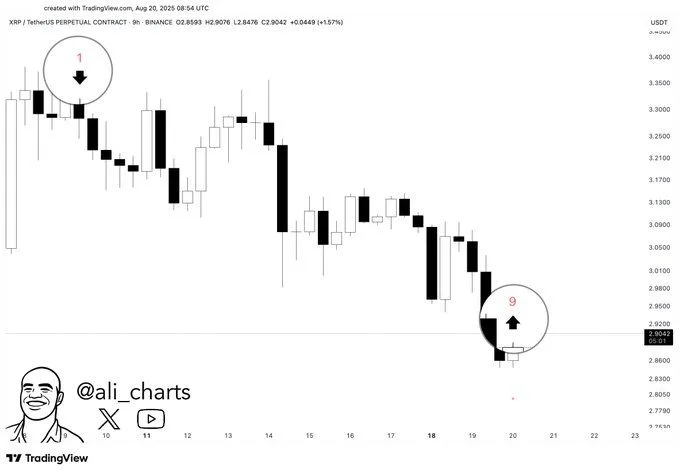XRP Anticipates a Positive Rebound from $2.90 as Market Trends Improve
Ali Martinez suggests that XRP is set to experience a vigorous rebound from the $2.90 threshold, indicating a fresh buying potential for traders and investors.
Martinez, recognized for his accurate market timing, recently highlighted XRP’s actions as a “perfectly timed top,” suggesting that the digital currency could be entering a bullish phase following a phase of consolidation.
In a mixed yet encouraging crypto market, XRP has stabilized around $2.90, establishing an important support zone. Martinez indicates a BUY signal has emerged, showcasing potential short-term profits for traders ready to seize market momentum.
XRP’s technical indicators reflect a bullish outlook, showing solid support, increasing trading volumes, and momentum trends that historically herald upward movements as the altcoin’s consolidation strengthens.
Consequently, Martinez believes that these indicators position XRP’s current price as a tactical entry point for both immediate returns and long-term growth.
Why XRP’s Compliance with ISO 20022 Differentiates It from Other Digital Assets
Crypto analyst SMQKE indicates that XRP’s adherence to the ISO 20022 standard is notable due to its unique incorporation within RippleNet’s On-Demand Liquidity (ODL), setting it apart from other digital currencies possessing Digital Token Identifiers (DTIs).
ISO 20022 is a universal messaging standard embraced by SWIFT and various financial entities to improve data quality and interoperability in financial transactions. While numerous cryptocurrencies promote ISO 20022 compatibility, XRP’s integration is significantly integrated within RippleNet’s framework.
SMQKE highlighted, XRP is unique because Ripple became the first blockchain member of the ISO 20022 Standards Body. RippleNet was developed around the ISO 20022 messaging framework that banks and payment providers are beginning to adopt.
The cryptocurrency researcher mentioned that XRP serves a vital role as the bridge asset for facilitating cross-border payments through RippleNet’s ODL, enhancing the efficiency of global transactions.
This technical congruence positions XRP as a potential asset for cross-border transactions with SWIFT-enabled organizations, likely streamlining settlement times and cutting transaction costs for institutional users.
Conversely, while other cryptocurrencies like Stellar (XLM) and Hedera (HBAR) also comply with ISO 20022, their integration into financial institutions is less pronounced. XRP’s unique placement within RippleNet’s framework facilitates a smoother connection with existing financial systems, distinguishing it from other digital currencies with DTIs.
SMQKE added, “Tokens that comply with ISO 20022 not only feature a DTI but also resolve specific issues with the SWIFT network, which is why they were chosen.”
Conclusion
SMQKE’s evaluation emphasizes XRP’s unique position in the changing landscape of digital currencies and conventional financial frameworks.
Its thorough integration with ISO 20022 standards and SWIFT infrastructure positions XRP as a leader in bridging the divide between cryptocurrencies and traditional banking systems.
However, it remains uncertain whether XRP will recover from the current psychological price point of $2.90.

